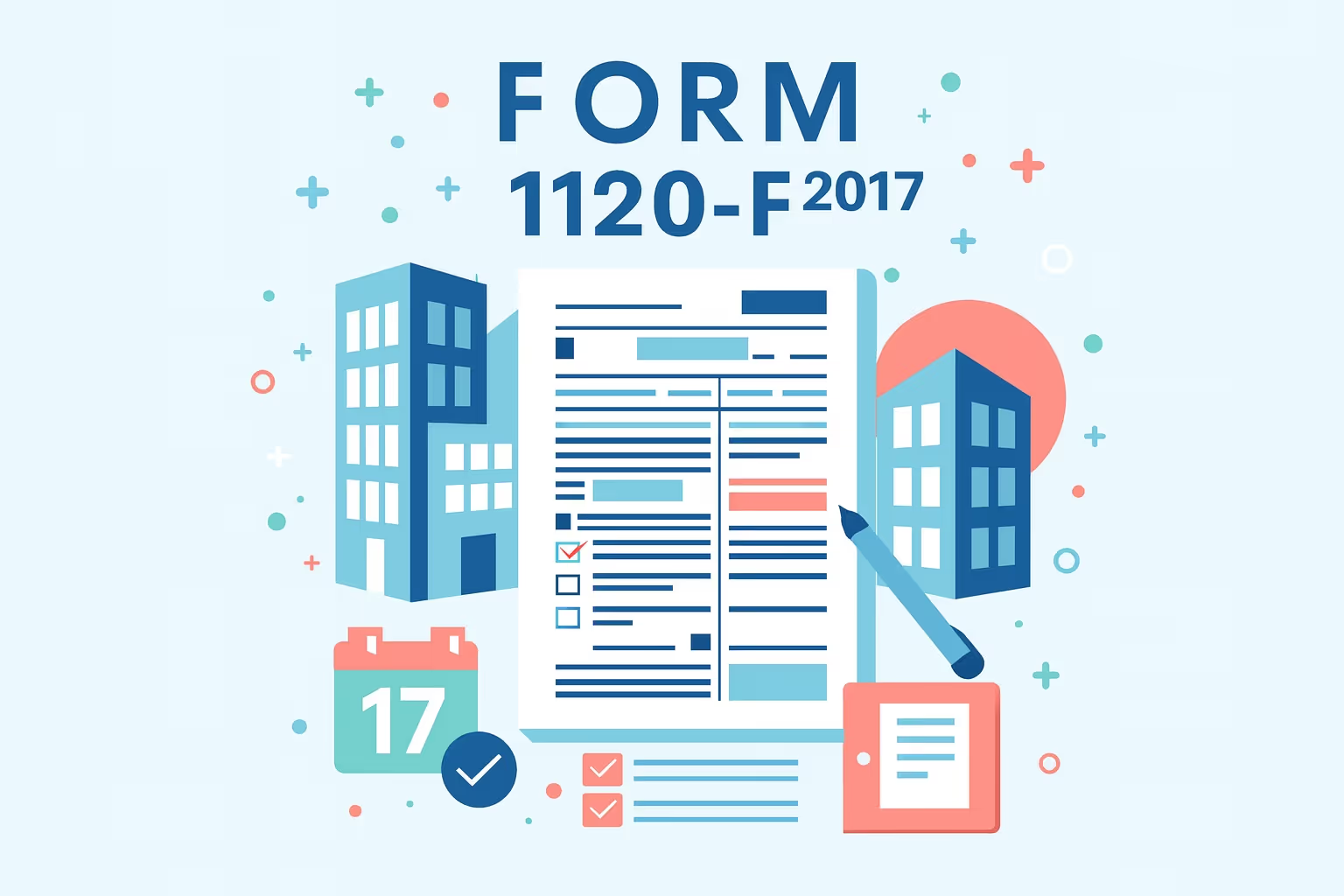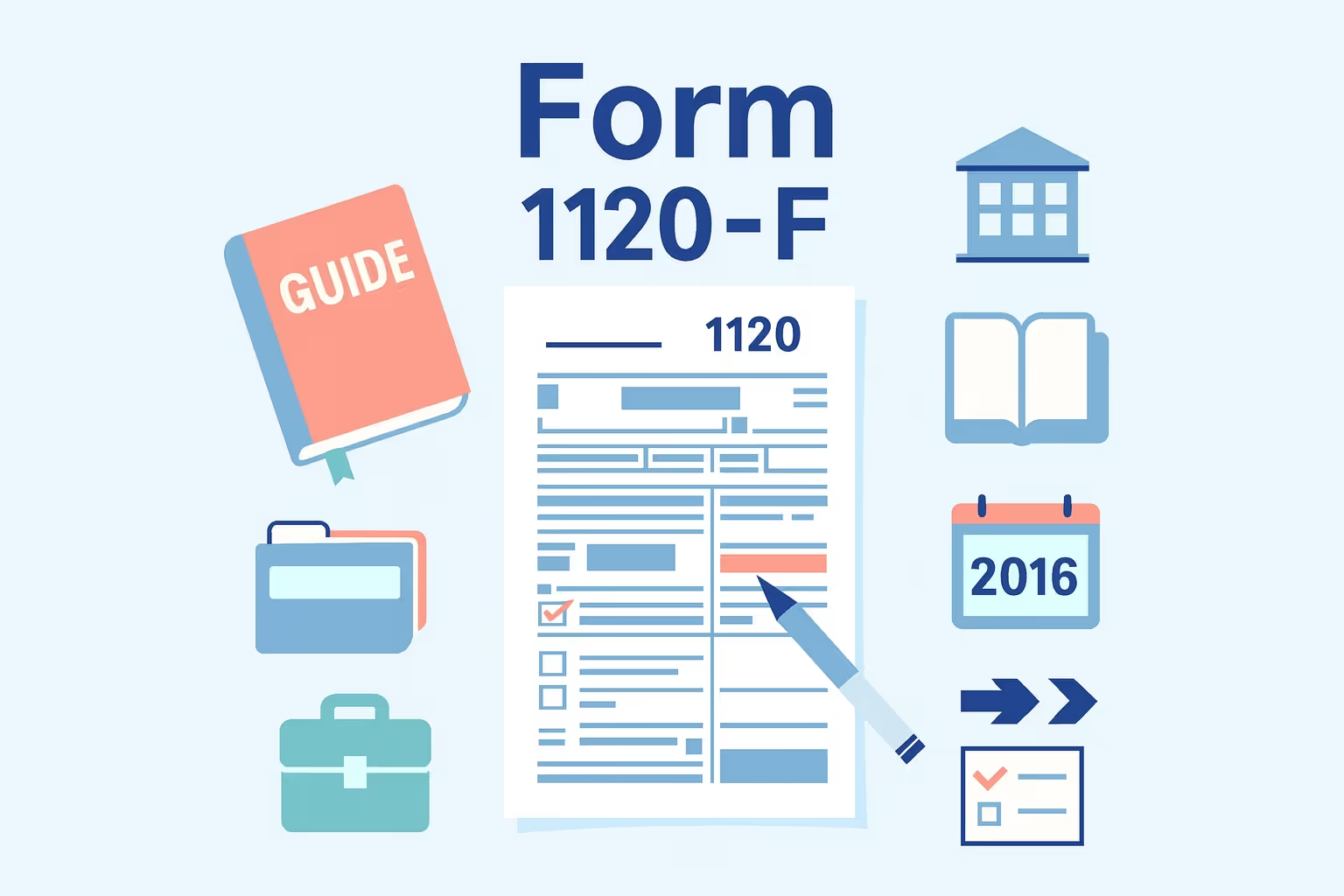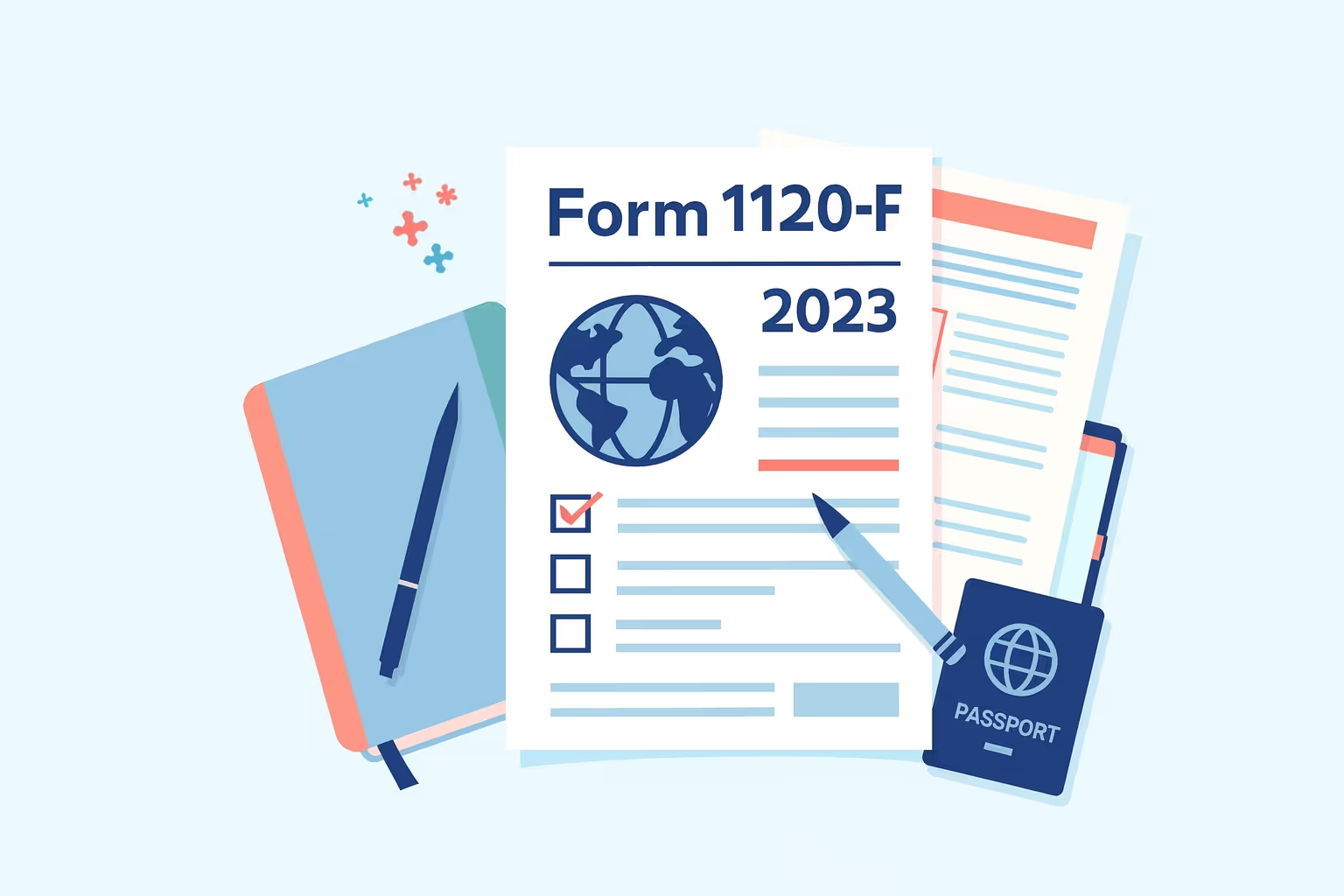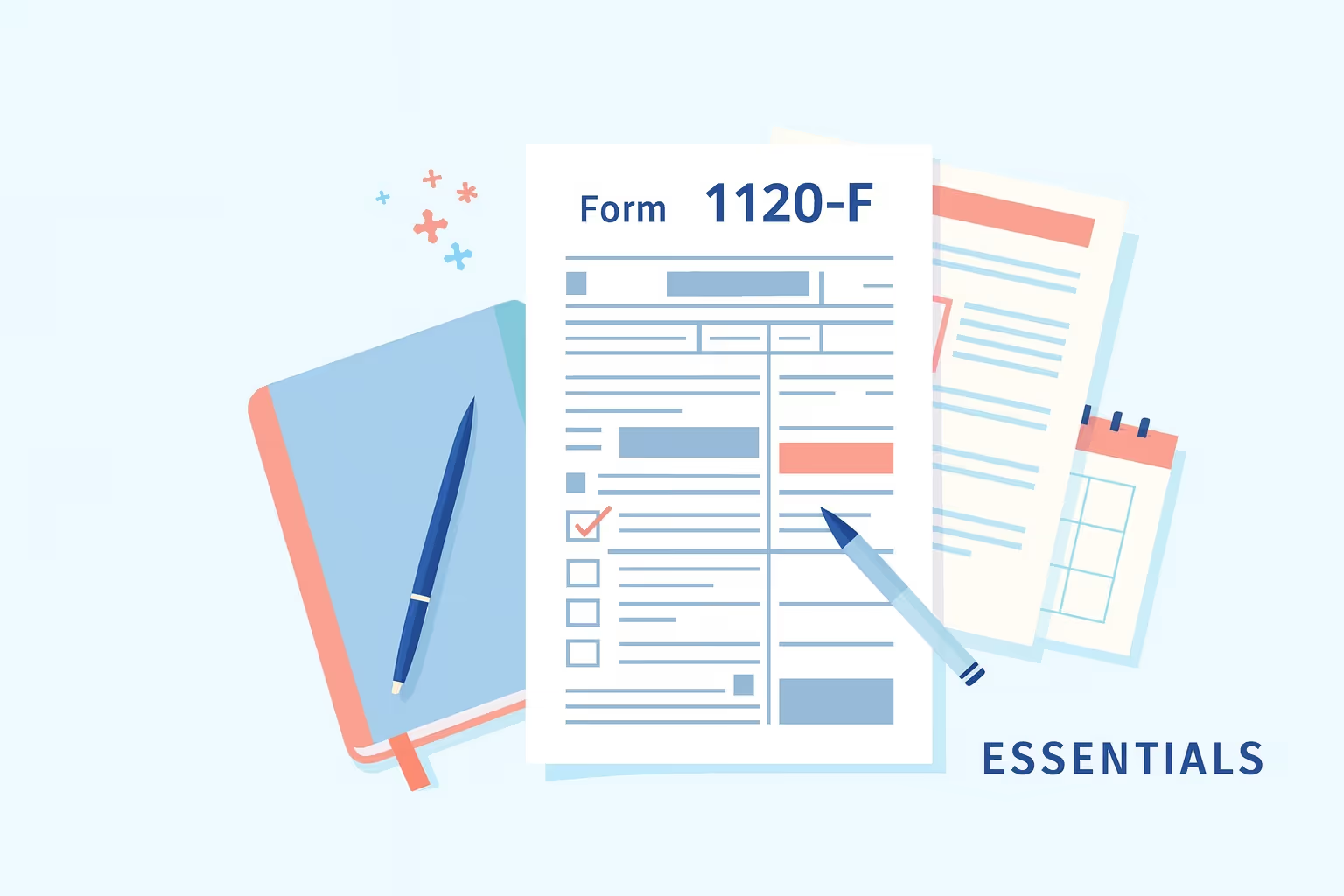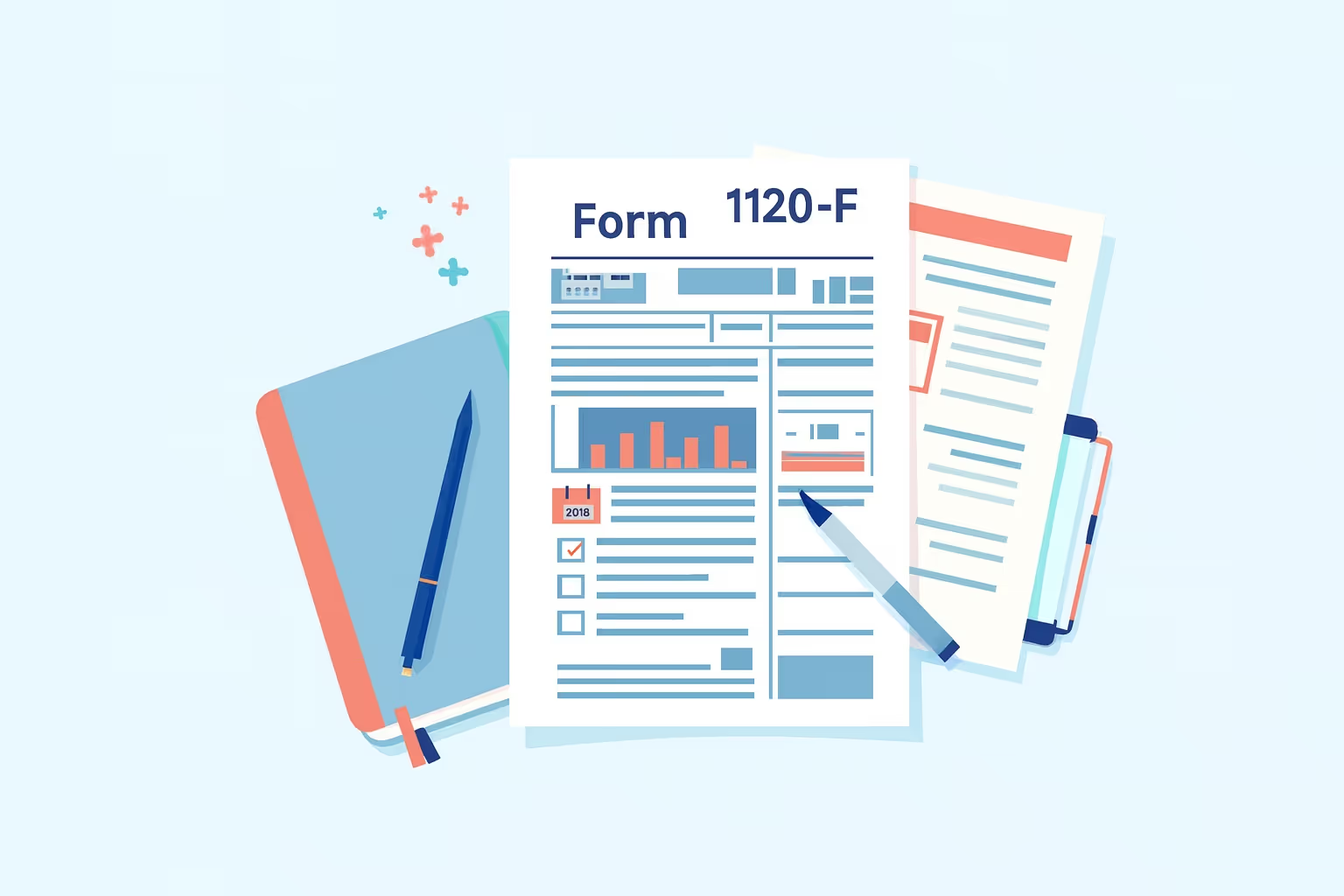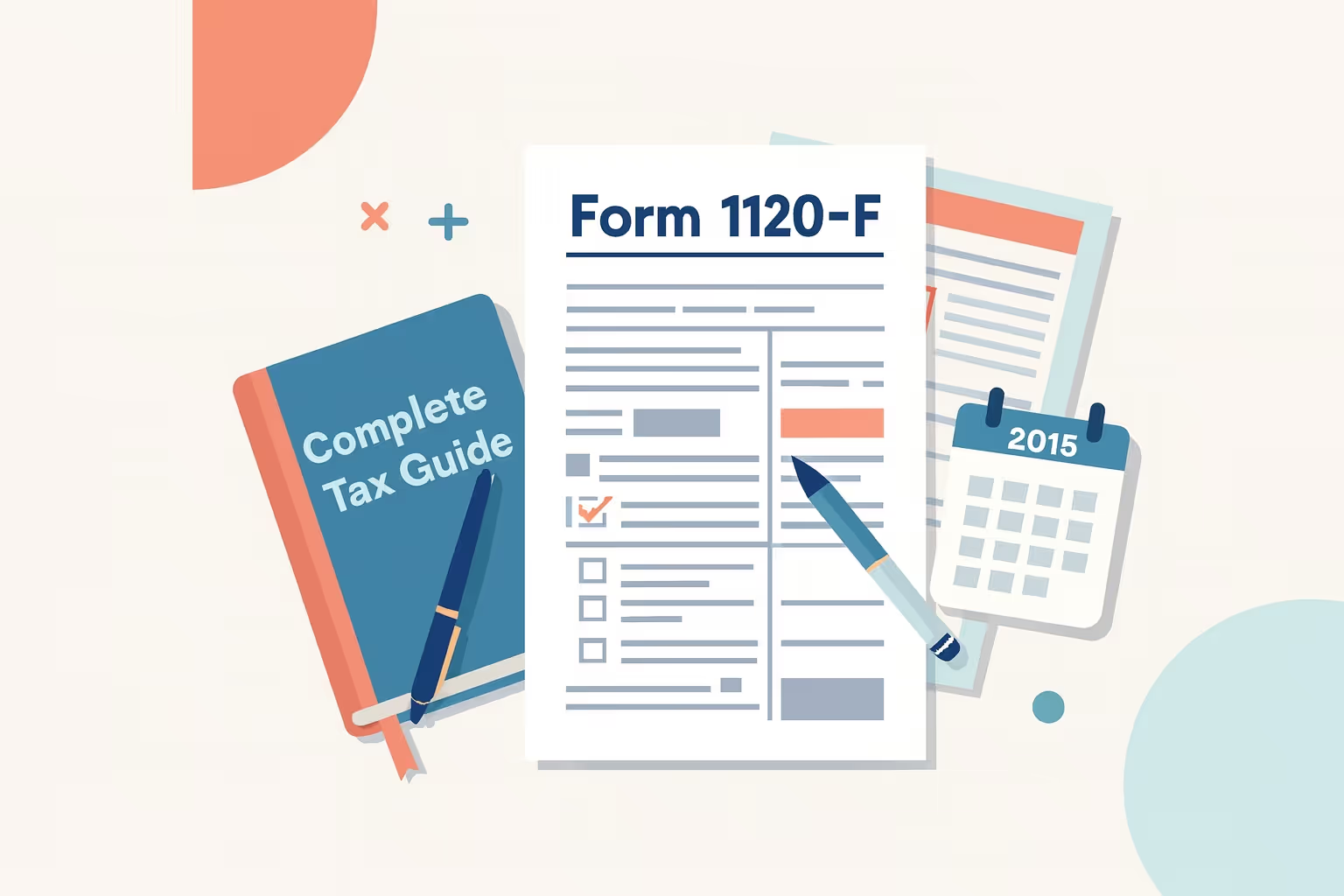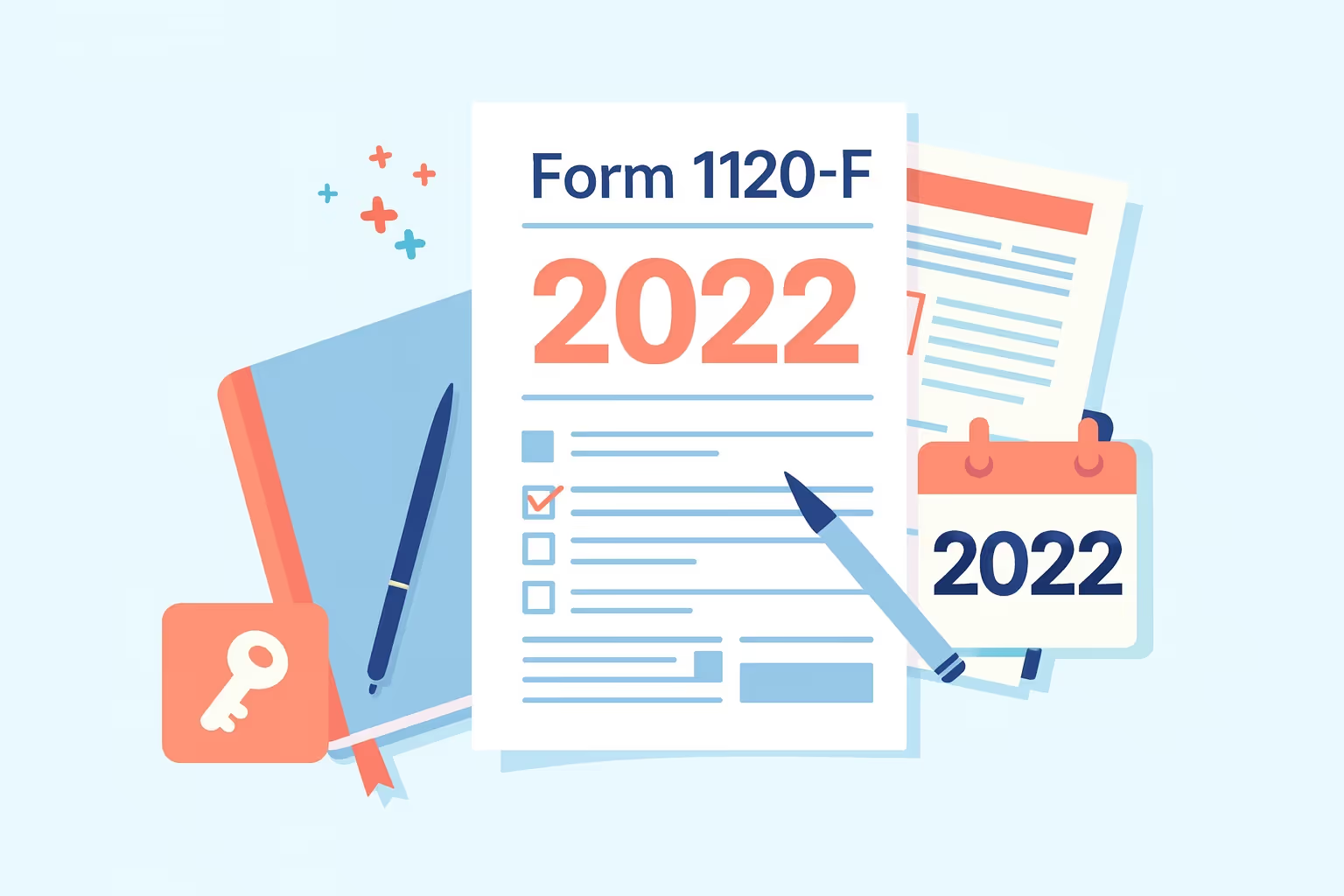Step-by-Step Guide to Form 1120-F 2024 Instructions
Form 1120-F, U.S. Income Tax Return of a Foreign Corporation, is the primary federal form foreign corporations use to report income, deductions, credits, and tax liability related to their business activities in the United States. The Internal Revenue Service (IRS) uses this return to determine whether a foreign corporation’s income is effectively connected with a U.S. trade or business and how much income tax is owed. Completing this form correctly is essential for maintaining compliance and avoiding penalties that could increase your organization’s tax obligations.
In U.S. tax law, Effectively Connected Income (ECI) refers to income arising from business in the United States. ECI is taxable at graduated corporate rates, allowing foreign corporations to claim deductions and credits when computing taxable income. This differs from income not effectively connected—such as dividends, royalties, or particular interest—which is generally taxed at a flat rate and may be reduced under an income tax treaty. Understanding this distinction is vital because misclassifying income can affect your tax computation and potential treaty benefits.
This Step-by-Step Guide to Form 1120-F 2024 Instructions walks you through how to file Form 1120-F accurately for the 2024 tax year. It covers filing requirements, electronic filing rules, payment methods, estimated tax payments, and key schedules required for compliance. Whether managing a single foreign corporation engaged in U.S. operations or multiple entities with source income, this guide provides detailed, accessible guidance to help you meet your tax obligations confidently and in alignment with IRS instructions.
Understanding Form 1120-F
Form 1120-F, U.S. Income Tax Return of a Foreign Corporation, is required by the Internal Revenue Service (IRS) for foreign corporations earning income from business in the United States. It reports gross income, deductions, credits, and tax liability related to effectively connected income (ECI).
Unlike domestic corporations filing Form 1120, foreign entities use Form 1120-F to document U.S.-source income and claim treaty benefits. You can review the official IRS publication at IRS Form 1120-F instructions for additional details.
Who Must File Form 1120-F
The IRS requires Form 1120-F from:
- Foreign corporations engaged in a U.S. trade or business must report all income effectively connected with their U.S. operations, even if some income is exempt under a tax treaty.
- Corporations with U.S.-source income not entirely withheld at the source. When withholding does not satisfy the full tax obligations, a formal filing is required to reconcile income tax liability.
- Entities making refund claims or treaty elections. Certain foreign corporations file to claim deductions, credits, or reduced rates under an income tax treaty.
- Qualified Derivatives Dealers (QDDs) and entities acting as trustees or receivers. These specialized entities file to report income tax exposure under U.S. law.
Why Filing Matters
Filing Form 1120-F accurately preserves a foreign corporation’s right to deductions and credits against effectively connected income. Failure to file may result in losing these benefits, leading to higher taxable income and greater tax liability.
In addition, late or missing returns may trigger IRS penalties and interest for unpaid tax. Timely filing helps maintain compliance, protects treaty benefits, and fully satisfies all tax obligations under current laws.
What’s New for Tax Year 2024
The Internal Revenue Service (IRS) made several important updates to the Form 1120-F 2024 instructions, which affect how foreign corporations file and report their U.S. income tax obligations. According to the official IRS instructions for Form 1120-F, these changes focus on improving accuracy, compliance, and electronic filing efficiency.
Key 2024 updates include:
- Mandatory electronic filing (e-filing): Corporations that file 10 or more returns of any type during the calendar year must now e-file Form 1120-F. This rule aligns with the IRS’s expanded electronic filing requirements and reduces filing errors.
- Higher penalties for late filing: For returns filed in 2025, the minimum penalty for failing to file on time—if the delay exceeds 60 days—is the smaller of the tax due or $510. This change highlights the importance of timely submission to avoid added tax liability.
- Corporate Alternative Minimum Tax (CAMT) relief: For tax year 2024, the IRS will waive penalties under section 6655 for corporations that fail to make estimated tax payments tied to CAMT obligations.
- Revised guidance for amended returns: The IRS clarified the process for submitting amended income tax returns and claiming corrections or refunds.
These updates ensure foreign corporations engaged in U.S. trade or business comply with current tax laws and fulfill their income tax return responsibilities for the 2024 fiscal year.
Before You Start: Gather Key Information
Before completing your Form 1120-F 2024 income tax return, ensure your corporation has all the required identification and financial records. Accurate, up-to-date documentation will help you determine your tax liability, report effectively connected income (ECI) correctly, and avoid delays in processing by the Internal Revenue Service (IRS).
Key information and documents to gather include:
- Employer Identification Number (EIN): Every foreign corporation in a U.S. trade or business must have an EIN. Apply early if you do not yet have one.
- Country of Incorporation and Principal Business Activity Code: These details help the IRS identify your entity and assign the correct tax obligations based on business activity.
- Financial Records: Gather balance sheets, profit-and-loss statements, and records of gross income, deductions, and credits for the fiscal tax year.
- Documentation of U.S.-source income: Include contracts, invoices, and receipts for rent paid, royalties, or other source income earned in the United States.
- Related-party information: Prepare Form 5472 if your corporation has transactions with related or unrelated parties that may affect taxable income.
- Treaty documentation: Keep copies of any income tax treaty claims and Form 8833 if you are asserting treaty benefits that modify normal tax implications.
Completing this checklist before you file Form 1120-F helps ensure accuracy, compliance, and timely reporting of your corporation’s income tax and estimated tax payments.
Step-by-Step Guide to Completing Form 1120-F
Step 1 — Header and Entity Information
Provide complete identification before you report income. Enter the legal name, address, and Employer Identification Number. Include the country, date of incorporation, and the ending fiscal tax year. Indicate the accounting method and any name changes. State whether the foreign corporation engaged in a U.S. trade or business during the tax year. This section frames the income tax return and ties your records to the Internal Revenue Service account.
Tips for accuracy:
- Use the correct principal business activity code, because tax rules and disclosures depend on it.
- Attach any required supporting documents in clear, labeled statements, such as explanations for reorganizations or method changes.
- Confirm that the electronic signature and e-filing details match your authorization records if you plan to e-file.
Step 2 — Section I: Income Not Effectively Connected (FDAP)
Report U.S.-source income that is not effectively connected with a trade or business. Include dividends, interest, royalties derived, rents, and annuities. Apply the statutory 30% or the tax treaty rate, if applicable. You cannot claim deductions in Section I unless an applicable income tax treaty allows them. Withholding may fully satisfy the tax liability, but you must still reconcile items here when required.
What to document:
- Provide detailed information on payors, amounts, and any treaty articles used.
- Keep supporting documents for related and unrelated parties, because treaty claims often require proof.
- Note any over-withholding or unpaid tax to coordinate with credits or refunds elsewhere on the return.
Step 3 — Section II: Effectively Connected Income (ECI)
Report effectively connected income from your business in the United States. Start with gross income (sales less returns and allowances) and calculate the cost of goods sold if applicable. Add other ECI items, such as interest, rents, and royalties related to such trade. Then, allowable tax deductions are computed to determine taxable income and the resulting tax computation. This is where a foreign corporation determines the core income tax liability for the year.
Allocation and interest rules:
- Schedule H is required when you have deductions on lines 12–27. The schedule allocates expenses between ECI and non-ECI under the Internal Revenue Code rules.
- Schedule I applies when you have interest expense. Follow the section 1.882-5 steps to compute deductible interest and any excess interest.
- Consider credits attributable to ECI, and coordinate with estimated tax payments made during the year.
Good practice:
- Maintain clear workpapers that show how you report income and allocate costs.
- Engage a qualified tax professional if you have complex structures or multiple branches.
Step 4 — Section III: Branch Profits Tax (BPT)
Determine whether the corporation owes branch profits tax on the “dividend equivalent amount.” Start with effectively connected earnings and profits, adjust for federal income tax, and measure changes in U.S. net equity. Apply the 30% rate or the reduced treaty benefits rate. If a treaty requires a permanent establishment, confirm the facts and disclosure.
Branch-level interest tax and planning:
- Compute any branch-level interest tax when liabilities are allocable to ECI. This often ties to the Schedule I interest calculations.
- Track capital movements because contributions and distributions affect U.S. net equity and future BPT exposure.
- Document treaty positions carefully, and attach related forms to support reduced rates when needed.
Final checks before you file Form 1120-F:
- Reconcile totals to financial statements and trial balances for the fiscal tax year.
- Review electronic filing requirements and the due date to avoid late filing penalties and the minimum penalty.
- Confirm that all disclosures, schedules, and elections appear once, are consistent, and match IRS instructions for Form 1120-F.
Required Schedules and Attachments
Several schedules and attachments may be required when preparing Form 1120-F 2024 to properly report income, deductions, and related transactions. These forms support transparency and ensure compliance with Internal Revenue Service (IRS) reporting standards for foreign corporations.
Key schedules and attachments include:
- Schedule H – Deductions Allocated to Effectively Connected Income (ECI)
Used to divide expenses between income that is effectively connected and income that is not. Required when claiming deductions on Section II lines 12–27. - Schedule I – Interest Expense Allocation
Calculates deductible interest under section 1.882-5 of the Internal Revenue Code, helping determine allowable tax deductions for excess interest or related party financing. - Schedule M-3 – Reconciliation of Net Income (Loss)
Mandatory for corporations with total assets of $10 million or more. Provides a detailed reconciliation between financial and taxable income, ensuring accuracy of tax computation. - Schedule P – Partnership Interests
List partnership interests that produce effectively connected income and reconcile each partner’s share of ECI or losses. - Schedule S – Section 883 Exclusion
Applies to certain foreign corporations engaged in shipping or aircraft operations that qualify for exclusion under section 883. - Schedule V – Vessels and Aircraft
Reports 4% tax on U.S.-source gross transportation income under section 887, where applicable. - Form 5472 – Related Party Transactions
Required when a foreign corporation has transactions with related parties. It must be filed separately for each reportable relationship. - Form 8833 – Treaty-Based Return Position Disclosure
Required when claiming treaty benefits that override U.S. tax laws. Ensures full disclosure of treaty-based positions to the IRS.
Attaching the correct schedules and forms helps the corporation meet its tax obligations and avoid processing delays. Each document should be reviewed before submission to confirm compliance with IRS instructions and income tax return requirements for the 2024 tax year.
How to File Form 1120-F
Filing Form 1120-F correctly ensures your foreign corporation meets its income tax return obligations and avoids unnecessary penalties. The Internal Revenue Service (IRS) allows both electronic filing (e-filing) and paper filing, but most foreign corporations must now file electronically under current tax laws.
E-Filing
Beginning in the 2024 tax year, corporations that file 10 or more returns during the calendar year must e-file Form 1120-F. This requirement helps the IRS reduce processing errors and confirm receipt more efficiently.
Advantages of e-filing include:
- Faster acknowledgment and fewer processing delays.
- Built-in validation that checks for missing data or inconsistent supporting documents.
- Secure transmission and immediate confirmation from the Internal Revenue Service Center.
To e-file, use an IRS-authorized provider or approved software compatible with the Form 1120-F 2024 instructions. Before submitting, verify the corporation’s EIN, review all schedules and attachments, and confirm electronic signatures.
Paper Filing
Paper filing is only allowed if your corporation qualifies for a waiver or exemption from electronic filing requirements. When filing by mail:
- Print clearly in black ink and do not staple forms or schedules.
- Sign and date the return, including the title of the authorized officer.
- Mail the return to the IRS processing center listed in Form 1120-F instructions.
Filing electronically remains the preferred method for most foreign corporations engaged in a U.S. trade or business, as it ensures compliance, accuracy, and timely submission of all income tax and supporting information.
Paying Taxes and Deadlines
The payment and filing deadlines for Form 1120-F depend on whether the foreign corporation maintains a U.S. office or place of business. The Internal Revenue Service (IRS) requires payments and filings to be made on time to avoid penalties and interest on unpaid taxes.
Filing and payment due dates:
- With a U.S. office, the income tax return is due on the 15th day of the 4th month after the close of the fiscal tax year.
- Without a U.S. office, the due date is the 15th day of the sixth month after the tax year ends.
- For corporations with a June 30 year-end, returns are due on the 15th day of the third month after the end of the tax year.
Payment methods accepted by the IRS:
- Electronic Federal Tax Payment System (EFTPS): Free, secure, and available 24/7 for scheduling estimated tax payments or same-day transactions.
- Direct Pay: Allows payment directly from a bank account without registration.
- Wire transfer: Best for same-day payments from international accounts but may include bank fees.
Timely estimated tax payments help reduce penalties and ensure your foreign corporation’s tax obligations are fully satisfied under U.S. tax laws. Always confirm deadlines in the latest IRS instructions for Form 1120-F to remain compliant.
Common Filing Errors to Avoid
Filing Form 1120-F can be complex, and even small mistakes can increase your tax liability or delay processing by the Internal Revenue Service (IRS). Careful preparation helps ensure your foreign corporation complies with U.S. tax laws and avoids unnecessary penalties.
Frequent errors include:
- Incorrect or missing EIN: A valid Employer Identification Number is required. Using the wrong number or leaving it blank may cause your income tax return to be rejected.
- Omitting signatures or titles: Unsigned forms are invalid. The return must include the authorized officer or representative's signature and title.
- Misclassifying income: Confusing effectively connected income (ECI) with non-ECI or FDAP income leads to incorrect tax computation and possible loss of deductions.
- Leaving out required schedules: Missing Form 5472, Form 8833, or Schedule M-3 can result in penalties and increased IRS scrutiny.
- Improper expense allocation: Deductions must be properly allocated between ECI and non-ECI using Schedule H and Schedule I. Inaccurate allocation inflates taxable income.
- Incorrect treaty claims: Claiming treaty benefits without meeting the qualified resident or limitation-on-benefits requirements may invalidate the exemption.
- Late filing or payment: Submitting after the due date triggers the minimum penalty of the lesser tax due or $510, plus interest on any unpaid tax.
Before you file Form 1120-F, review the entire return, verify calculations, and confirm all supporting documents are attached. A qualified tax professional can help prevent these errors and ensure compliance with current IRS instructions and income tax obligations.
Zero-Activity or Dormant Year Filing
Even if your foreign corporation had no income or operations in the United States during the tax year, the Internal Revenue Service (IRS) may still require a filing. Submitting Form 1120-F during an inactive year helps maintain compliance and preserve necessary tax rights.
Key points to remember:
- Protect your filing rights: If you are unsure whether your corporation has a U.S. trade or business or effectively connected income (ECI), file a protective return. This safeguards the right to claim deductions and treaty benefits in the future.
- Maintain compliance: Even without current activity, filing prevents potential penalties for noncompliance under U.S. tax laws.
- Final return requirements: If the corporation permanently ceases operations, file a final return, report all U.S.-source income, and confirm that all tax obligations are settled.
- Avoid future issues: Timely protective or zero-activity filings ensure continued eligibility for deductions and treaty protections in later years.
First-Time Filer Tips
Filing Form 1120-F for the first time can be complex, but following a few essential steps will help your foreign corporation comply with U.S. tax laws and avoid common mistakes.
- Obtain an Employer Identification Number (EIN) using Form SS-4 or the IRS website before submitting your income tax return.
- Confirm your entity’s classification and, if needed, file Form 8832 to elect the appropriate status under the Internal Revenue Code.
- Register for the Electronic Federal Tax Payment System (EFTPS) to make secure, timely estimated tax payments to the Internal Revenue Service (IRS).
- Maintain organized financial records that separate U.S.-source income from foreign operations and include all supporting documents for deductions or treaty benefits.
- Consult a qualified tax professional to ensure proper filing, understand your tax obligations, and minimize the risk of penalties or misreporting.
Key Concepts: ECI vs. FDAP and Treaty Benefits
Understanding the difference between Effectively Connected Income (ECI) and Fixed, Determinable, Annual, or Periodical (FDAP) income is essential for accurate reporting on Form 1120-F.
- Effectively Connected Income (ECI) includes income earned from a trade or business in the United States. It is taxed on a net basis, allowing foreign corporations to deduct related expenses and determine taxable income under the Internal Revenue Code.
- FDAP income includes passive types of U.S.-source income, such as dividends, interest, rents, and royalties, which are generally taxed at a flat 30% rate unless reduced by a tax treaty.
- Treaty benefits may reduce or eliminate withholding on FDAP income or lower the branch profits tax rate. To claim these benefits, the corporation must meet qualified resident and limitation-on-benefits (LOB) requirements and disclose them using Form 8833.
Applying these concepts correctly ensures compliance with U.S. tax laws and helps foreign corporations effectively manage their overall tax liability.
Frequently Asked Questions (FAQs)
Who needs to file Form 1120-F?
Any foreign corporation engaged in a business in the United States or earning effectively connected income (ECI) must file Form 1120-F. This also applies to entities claiming treaty benefits, making refund requests, or acting as qualified derivatives dealers (QDDs). Filing helps determine the corporation’s income tax liability and ensures compliance with Internal Revenue Service (IRS) requirements.
What is the filing deadline for corporations without a U.S. office?
If your foreign corporation does not maintain a U.S. office, Form 1120-F is due on the 15th day of the sixth month after the end of the fiscal tax year. Missing this deadline may result in penalties, interest on unpaid tax, or loss of deductions. Always verify in the latest IRS instructions before filing.
How do I determine if my income is ECI or FDAP?
Income is effectively connected (ECit) if earned through a U.S. trade or business and passes the asset-use or business-activities test. FDAP income, such as dividends or royalties, is taxed at 30% unless reduced by treaty. ECI is taxed on a net basis and allows deductions, while FDAP does not.
Are estimated tax payments required for Form 1120-F?
Foreign corporations with expected tax liability must make estimated tax payments quarterly through the Electronic Federal Tax Payment System (EFTPS) or another IRS-approved option. Timely payments prevent penalties, underpayment interest, and excess interest charges. Maintain detailed records showing how each payment applies to the corporation’s income, as these documents support accuracy and compliance during IRS review.
What is the branch profits tax, and how is it calculated?
The branch profits tax applies to after-tax earnings of a foreign corporation’s U.S. branch that are not reinvested in business in the United States. The standard rate is 30%, though an income tax treaty may reduce it. The tax is based on effectively connected earnings, profits, and changes in U.S. net equity, ensuring proper assessment of the corporation’s income from U.S. operations.
















